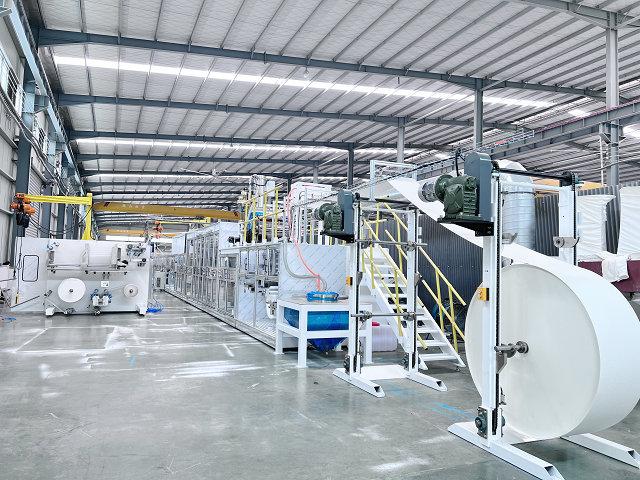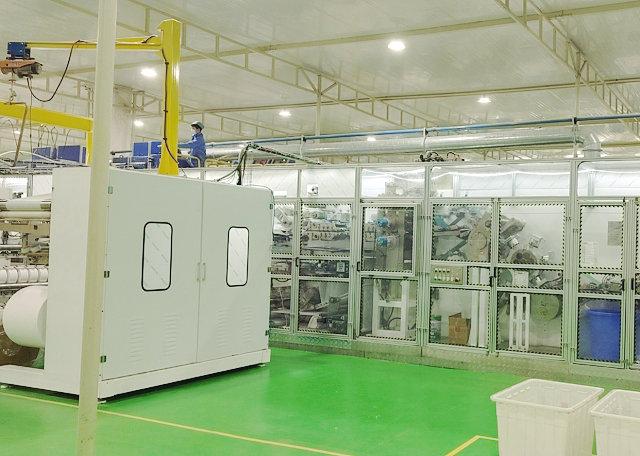Author:Haina Machinery Factory FROM:Diaper Machinery Manufacturer TIME:2024-11-14
Sanitary pads are essential products for menstrual hygiene, providing comfort and protection for individuals during their periods. The production of sanitary pads involves various raw materials, each chosen for its specific properties to ensure effectiveness, safety, and comfort. This article explores the common raw materials used in the manufacturing of sanitary pads, detailing their roles and contributions to the final product.

The absorbent core is the heart of any sanitary pad, responsible for absorbing menstrual fluid. The most common material used for this purpose is superabsorbent polymer (SAP), a highly effective material that can absorb many times its weight in liquid. SAP is often blended with fluff pulp, which is made from wood fibers. Fluff pulp provides bulk and helps distribute the liquid evenly throughout the pad, enhancing absorption and preventing leaks. Together, these materials create a highly efficient absorbent layer.
The top sheet is the layer that comes into direct contact with the skin. It is crucial for providing comfort and preventing irritation. Typically made from non-woven fabric, the top sheet is designed to be soft, breathable, and moisture-wicking. Polypropylene and polyethylene are common synthetic fibers used, as they help keep the surface dry while allowing air circulation. Some brands also incorporate natural fibers for added softness and hypoallergenic properties.
The back sheet serves as a protective barrier, preventing leaks from seeping through to clothing. This layer is usually made from a waterproof material such as polyethylene film. The back sheet must be durable yet flexible, ensuring that it adheres well to the pad while allowing for movement. In some eco-friendly products, biodegradable materials may be used to reduce environmental impact, offering a sustainable alternative to traditional plastic films.

Adhesives are critical in the assembly of sanitary pads, helping to bond various layers together and ensuring that the pad stays in place during use. Hot melt adhesives are commonly used due to their strong bonding properties and quick setting times. Additionally, some manufacturers opt for water-based adhesives, which are considered more environmentally friendly. The choice of adhesive can affect the overall performance and safety of the product, making it an important consideration in production.

Many sanitary pads include fragrances or additives designed to enhance user experience. While fragrances can help mask odors, it is important for manufacturers to carefully consider the potential for skin irritation. Natural fragrances or essential oils are sometimes used as alternatives to synthetic scents to minimize allergic reactions. Furthermore, some pads incorporate additional features such as antimicrobial agents to reduce bacteria growth and enhance hygiene.
The packaging of sanitary pads is also an essential aspect of their production, impacting product safety and usability. Most sanitary pads are individually wrapped in plastic or paper to maintain hygiene and prevent contamination. The choice of packaging material can influence both the ease of use and the environmental footprint of the product. Eco-conscious brands are increasingly exploring biodegradable or recyclable packaging solutions to appeal to environmentally aware consumers.
With growing awareness of environmental issues, many manufacturers are looking to incorporate sustainable practices and materials into their production processes. This includes using organic cotton for the top sheet, biodegradable materials for the absorbent core, and eco-friendly packaging. Brands are increasingly transparent about their sourcing and manufacturing practices, appealing to consumers who prioritize sustainability in their purchasing decisions.
The production of sanitary pads involves a careful selection of raw materials, each playing a vital role in ensuring comfort, effectiveness, and safety. From absorbent cores to protective back sheets, each material is chosen based on its specific properties and benefits. As consumer awareness regarding sustainability grows, the sanitary pad industry is evolving to include more eco-friendly options, reflecting a shift towards greater environmental responsibility. Understanding these raw materials not only highlights the complexity of sanitary pad production but also empowers consumers to make informed choices regarding their menstrual hygiene products.
